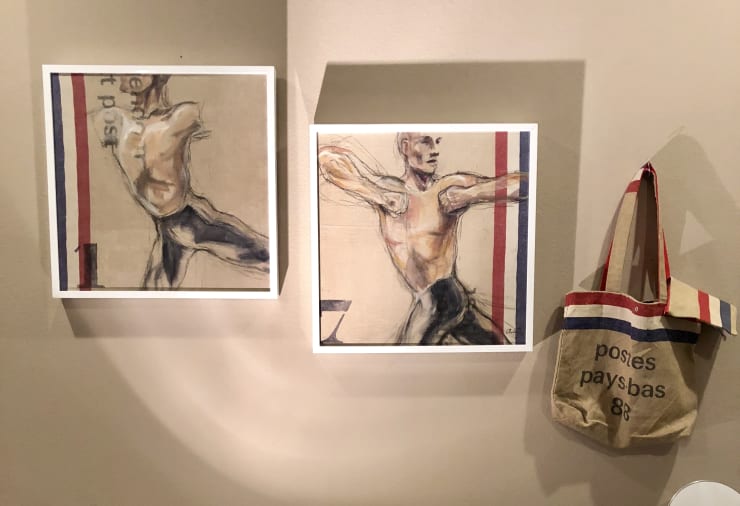Jane Emerging
1 Mail Man on a Motorbike
Iconic Royal Mail Post Boxes is a captivating collection that celebrates the enduring legacy of the United Kingdom's postal heritage. This set features seven meticulously crafted post boxes, each approximately 3 inches tall, alongside a mailman on a motorbike, embodying the quintessential British charm. The vibrant red and blue hues of the post boxes, coupled with the detailed design of the motorbike, create a vivid tableau that captures the essence of traditional mail delivery. This artwork serves as a nostalgic homage to the iconic symbols that have become an integral part of the UK's cultural landscape.
About Artwork: Iconic Royal Mail Post Boxes
Created with an eye for detail, this piece brings to life the historical significance of the Royal Mail post boxes, which are not only functional but also cherished emblems of British identity. With each box standing at approximately 3 inches, the collection is compact yet impactful, making it a versatile addition to any display. The medium, combining both canvas and bronze, offers a tactile and visual richness that enhances its appeal. This artwork invites viewers to reflect on the evolution of communication and the enduring symbols that connect past and present, making it a valuable piece for collectors interested in cultural and historical narratives.
Provenance
London, EnglandLiterature
The history of the Royal Mail post box is a fascinating journey that reflects the evolution of postal services and British identity:
Early Days and Experimentation (Mid-19th Century):
Inspired by Europe: The concept of roadside letter boxes was inspired by their use in France and other European countries.
Channel Islands First: The first public post boxes in the UK were installed in Jersey in 1852, thanks to the advocacy of Anthony Trollope, a Post Office official and later a famous novelist.
Mainland Follows: The first mainland pillar box was erected in Carlisle in 1853. London received its first post boxes in 1855.
Variety of Designs: Initially, the design and manufacture of post boxes were largely the responsibility of local surveyors, leading to a wide array of shapes and styles. Early forms were often hexagonal or fluted.
Green Beginnings: The first standard color for post boxes, adopted in 1859, was bronze green, intended to be unobtrusive. However, this proved to be too inconspicuous, with people struggling to locate them.
Standardization and the Rise of Red (Late 19th Century):
First National Standard: In 1859, the first "National Standard" post box was introduced, aiming for uniformity. These were cylindrical with a hexagonal cap and painted green.
The Penfold Box: Designed by J.W. Penfold, this ornate hexagonal box with decorative elements became a standard in 1866. Although aesthetically pleasing, it was expensive to produce.
The Iconic Red: In 1874, the color of post boxes was changed to red to improve visibility and address public complaints. It took about ten years for the entire country to be repainted.
Cylindrical Dominance: By 1879, the cylindrical design with a convex circular lid became the standard, a form still recognizable today.
20th Century and Beyond:
Lamp Boxes: Smaller, more economical boxes designed to attach to lamp posts appeared in 1896, serving areas with lower mail volumes.
Airmail Boxes: In the 1930s, blue post boxes were briefly introduced for airmail, but these were later repainted red for general use.
Royal Cyphers: Post boxes began featuring the royal cypher (initials of the reigning monarch) to signify their connection to the Royal Mail. This practice continues, making it possible to date post boxes to a specific reign (e.g., VR for Victoria, GR for George VI, EIIR for Elizabeth II).
Modern Variations: While the cylindrical red pillar box remains the most common, some 20th-century experiments included square steel boxes (which were not very popular). More recent additions include larger capacity boxes and those made of different materials like glass-reinforced plastic, often found in shopping centers.
Gold Post Boxes: In 2012, Royal Mail painted some post boxes gold to commemorate the gold medal winners of the London Olympics in their hometowns.
- X
- Tumblr
-
 Anita Gaasbeek-Ruigrok, Dutch postal dancers, 2018Sold6,500.00
Anita Gaasbeek-Ruigrok, Dutch postal dancers, 2018Sold6,500.00
Collection | Artists | Contact
Find us on Chairish
This website uses cookies
This site uses cookies to help make it more useful to you. Please contact us to find out more about our Cookie Policy.
Join our mailing list
* denotes required fields
We will process the personal data you have supplied in accordance with our privacy policy (available on request). You can unsubscribe or change your preferences at any time by clicking the link in our emails.


